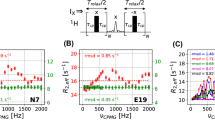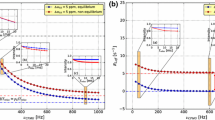Abstract
In the analysis of the constant-time Carr-Purcell-Meiboom-Gill (CT-CPMG) relaxation dispersion experiment, chemical exchange parameters, such as rate of exchange and population of the exchanging species, are typically optimized using equations that predict experimental relaxation rates recorded as a function of effective field strength. In this process, the effect of chemical exchange during the CPMG pulses is typically assumed to be the same as during the free-precession. This approximation may introduce systematic errors into the analysis of data because the number of CPMG pulses is incremented during the constant-time relaxation period, and the total pulse duration therefore varies as a function of the effective field strength. In order to estimate the size of such errors, we simulate the time-dependence of magnetization during the entire constant time period, explicitly taking into account the effect of the CPMG pulses on the spin relaxation rate. We show that in general the difference in the relaxation dispersion profile calculated using a practical pulse width from that calculated using an extremely short pulse width is small, but under certain circumstances can exceed 1 s−1. The difference increases significantly when CPMG pulses are miscalibrated.





Similar content being viewed by others
References
Allard P, Helgstrand M, Hard T (1997) A method for simulation of NOESY, ROESY, and Off-resonance ROESY spectra. J Magn Reson 129:19–29
Allard P, Helgstrand M, Hard T (1998) The complete homogeneous master equation for a heteronuclear two-spin system in the basis of Cartesian product operators. J Magn Reson 134:7–16
Beach H, Cole R, Gill ML, Loria JP (2005) Conservation of mu s-ms enzyme motions in the apo- and substrate-mimicked state. J Am Chem Soc 127:9167–9176
Brath U, Akke M, Yang D, Kay LE, Mulder FA (2006) Functional dynamics of human FKBP12 revealed by methyl 13C rotating frame relaxation dispersion NMR spectroscopy. J Am Chem Soc 128:5718–5727
Carver JP, Richards RE (1972) General 2-site solution for chemical exchange produced dependence of T2 upon Carr-Purcell pulse separation. J Magn Reson 6:89–105
Eisenmesser E, Millet O, Labeikovsky W, Korzhnev D, Wolf-Watz M, Bosco DA, Skalicky JJ, Kay LE, Kern D (2005) Intrinsic dynamics of an enzyme underlies catalysis. Nature 438:117–121
Ghose R, Fushman D, Cowburn D (2001) Determination of the rotational diffusion tensor of macromolecules in solution from nmr relaxation data with a combination of exact and approximate methods—application to the determination of interdomain orientation in multidomain proteins. J Magn Reson 149:204–217
Hansen DF, Yang D, Feng H, Zhou Z, Wiesner S, Bai Y, Kay LE (2007) An exchange-free measure of 15N transverse relaxation: an NMR spectroscopy application to the study of a folding intermediate with pervasive chemical exchange. J Am Chem Soc 129:11468–11478
Hass MA, Vlasie MD, Ubbink M, Led JJ (2009) Conformational exchange in pseudoazurin: different kinds of microsecond to millisecond dynamics characterized by their pH and buffer dependence using 15N NMR relaxation. Biochemistry 48:50–58
Ishima R, Torchia DA (2003) Extending the range of amide proton relaxation dispersion experiments in proteins using a constant-time relaxation-compensated CPMG approach. J Biomol NMR 25:243–248
Ishima R, Torchia DA (2006) Accuracy of optimized chemical-exchange parameters derived by fitting CPMG R2 dispersion profiles when R2(0a) not = R2(0b). J Biomol NMR 34:209–219
Korzhnev DM, Kloiber K, Kay LE (2004) Multiple-quantum relaxation dispersion NMR spectroscopy probing. J Am Chem Soc 126:7320–7329
Korzhnev DM, Neudecker P, Zarrine-Afsar A, Davidson AR, Kay LE (2006) Abp1p and Fyn SH3 domains fold through similar low-populated intermediate states. Biochemistry 45:10175–10183
Kovrigin EL, Kempf JG, Grey MJ, Loria JP (2006) Faithful estimation of dynamics parameters from CPMG relaxation dispersion measurements. J Magn Reson 180:83–104
Labeikovsky W, Eisenmesser EZ, Bosco DA, Kern D (2007) Structure and dynamics of pin1 during catalysis by NMR. J Mol Biol 367:1370–1381
Long D, Liu M, Yang D (2008) Accurately probing slow motions on millisecond timescales with a robust NMR relaxation experiment. J Am Chem Soc 130:2432–2433
Loria JP, Rance M, Palmer AG (1999) A relaxation-compensated Carr-Purcell-Meiboom-Gill sequence for characterizing chemical exchange by NMR spectroscopy. J Am Chem Soc 121:2331–2332
Loria JP, Berlow RB, Watt ED (2008) Characterization of enzyme motions by solution NMR relaxation dispersion. Acc Chem Res 41:212–221
Luz Z, Meiboom S (1963) Nuclear magnetic resonance study of the protolysis of trimethylammonium ion in aqueous solution—order of the reaction with respect to solvent. J Chem Phys 39:366–370
McConnell HM (1958) Reaction rates by nuclear magnetic resonance. J Chem Phys 28:430–431
Meiboom S, Gill D (1958) Modified spin-echo method for measuring nuclear relaxation times. Rev Sci Instrm 29:688–691
Mulder FA, Hon B, Mittermaier A, Dahlquist FW, Kay LE (2002) Slow internal dynamics in proteins: application of NMR relaxation dispersion spectroscopy to methyl groups in a cavity mutant of T4 lysozyme. J Am Chem Soc 124:1443–1451
Myint W, Gong Q, Ishima R (2009) Practical aspects of 15N CPMG transverse relaxation experiments for proteins in solution. Concepts Magn Reson 34A:63–75
Palmer AG 3rd, Massi F (2006) Characterization of the dynamics of biomacromolecules using rotating-frame spin relaxation NMR spectroscopy. Chem Rev 106:1700–1719
Ross A, Czisch M, King GC (1997) Systematic errors associated with the CPMG pulse sequence and their effect on motional analysis of biomolecules. J Magn Reson 124:355–365
Skrynnikov NR, Dahlquist FW, Kay LE (2002) Reconstructing NMR spectra of “invisible” excited protein states using. J Am Chem Soc 124:12352–12360
Sugase K, Dyson HJ, Wright PE (2007) Mechanism of coupled folding and binding of an intrinsically disordered protein. Nature 447:1021–1025
Tolkatchev D, Xu P, Ni F (2003) Probing the kinetic landscape of transient peptide-protein interactions by use of peptide (15)n NMR relaxation dispersion spectroscopy: binding of an antithrombin peptide to human prothrombin. J Am Chem Soc 125:12432–12442
Tollinger M, Skrynnikov NR, Mulder FA, Forman-Kay JD, Kay LE (2001) Slow dynamics in folded and unfolded states of an SH3 domain. J Am Chem Soc 123:11341–11352
Valentine ER, Palmer AG 3rd (2005) Microsecond-to-millisecond conformational dynamics demarcate the GluR2. Biochemistry 44:3410–3417
Wang C, Grey MJ, Palmer AG 3rd (2001) CPMG sequences with enhanced sensitivity to chemical exchange. J Biomol NMR 21:361–366
Yip GN, Zuiderweg ER (2004) A phase cycle scheme that significantly suppresses offset-dependent artifacts in the R2-CPMG 15N relaxation experiment. J Magn Reson 171:25–36
Acknowledgments
We thank Eva Meirovitch, Daiwen Yang, and Dennis Torchia for useful discussions and/or critical reading of the manuscript. This study was financially supported by the American Heart Association (Great Rivers affiliate) new investigator grant 0765348U, and National Science Foundation research grant MCB 0814905. Supplementary material is available.
Author information
Authors and Affiliations
Corresponding author
Electronic supplementary material
Below is the link to the electronic supplementary material.
Rights and permissions
About this article
Cite this article
Myint, W., Ishima, R. Chemical exchange effects during refocusing pulses in constant-time CPMG relaxation dispersion experiments. J Biomol NMR 45, 207–216 (2009). https://doi.org/10.1007/s10858-009-9344-9
Received:
Accepted:
Published:
Issue Date:
DOI: https://doi.org/10.1007/s10858-009-9344-9




